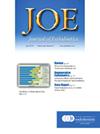Links between Nosocomial Endodontic Infections and Bacteremia Associated with Apical Periodontitis and Endodontic Treatment
IF 3.5
2区 医学
Q1 DENTISTRY, ORAL SURGERY & MEDICINE
引用次数: 0
Abstract
Introduction
Nosocomial endodontic infections can cause treatment failure and are potential risk of bacteremia. This study is aimed to investigate bacteremia associated with apical periodontitis and immediate postendodontic treatment using next-generation sequencing. The study will also elucidate if the endodontic nosocomial pathogens are present in the blood microbiome.
Methods
Saliva, blood, and intracanal samples were collected from patients undergoing endodontic treatment (n = 65), while gloves samples were collected from the operator. Bacterial DNA was extracted and the targeted 16S ribosomal ribonucleic acid gene was sequenced using the Illumina Miseq 300 platform for the V1-V2 hypervariable region. The alpha and beta diversities were carried out using the phyloseq package (version-1.36.0) in R (version-4.1). Differences in abundance and diversity were calculated using Mann-Whitney test. Linear discriminant analysis Effect Size was used to compare the biological relevance between different sample sources.
Results
The phyla firmicutes, actinobacteria, proteobacteria, and bacteroidetes were identified from all sample sources. In blood and glove samples, Cutibacterium genus was highly abundant (14.6%, 17.7%, respectively), while in intracanal samples, Enterococcus took precedence (18.2%). Saliva samples exhibited Prevotella as the most abundant genera (17.9%). Common genera were present between intracanal and postoperative blood samples. Circos graph showed that all the phyla identified from a patient were consistently present in all the samples investigated from the same patient.
Conclusions
Nosocomial endodontic pathogens being predominant in both; gloves and blood samples, along with common genera present in all sample sources, suggests a potential pathway of transfer of pathogens from saliva to gloves, intracanal, and blood, thus providing evidence of nosocomial endodontic bacteremia.
与根尖牙周炎和牙髓治疗相关的牙髓非典型感染和菌血症之间的联系。
导言:非典型牙髓感染可导致治疗失败,并具有潜在的菌血症风险。本研究旨在利用新一代测序技术调查与根尖牙周炎和牙髓治疗后相关的菌血症。该研究还将阐明血液微生物组中是否存在牙髓病病原菌:从接受牙髓治疗的患者(n=65)处采集唾液、血液和牙槽内样本,同时从操作者处采集手套样本。提取细菌 DNA,并使用 Illumina Miseq 300 平台对目标 16S rRNA 基因的 V1-V2 超变区进行测序。使用 R(4.1 版)中的 phyloseq 软件包(1.36.0 版)进行了α和β多样性分析。丰度和多样性差异采用 Mann-Whitney 检验进行计算。线性判别分析效应大小用于比较不同样本来源之间的生物相关性:结果:在所有样本来源中都鉴定出了固缩菌门、放线菌门、变形菌门和类杆菌门。在血液和手套样本中, Cutibacterium 属的数量较多(分别为 14.6%和 17.7%),而在肛门内样本中,Enterococcus 属的数量最多(18.2%)。唾液样本中最多的菌属是前驱菌(17.9%)。龋齿内样本和术后血液样本中都有常见菌属。圆环图显示,从一名患者身上鉴定出的所有菌属在从同一患者身上调查出的所有样本中都一致存在:牙体牙髓病病原体在手套和血液样本中均占主导地位,而且所有样本来源中均存在共同的菌属,这表明病原体可能通过唾液转移到手套、牙槽内和血液中,从而提供了牙体牙髓病菌血症的证据。
本文章由计算机程序翻译,如有差异,请以英文原文为准。
求助全文
约1分钟内获得全文
求助全文
来源期刊

Journal of endodontics
医学-牙科与口腔外科
CiteScore
8.80
自引率
9.50%
发文量
224
审稿时长
42 days
期刊介绍:
The Journal of Endodontics, the official journal of the American Association of Endodontists, publishes scientific articles, case reports and comparison studies evaluating materials and methods of pulp conservation and endodontic treatment. Endodontists and general dentists can learn about new concepts in root canal treatment and the latest advances in techniques and instrumentation in the one journal that helps them keep pace with rapid changes in this field.
 求助内容:
求助内容: 应助结果提醒方式:
应助结果提醒方式:


